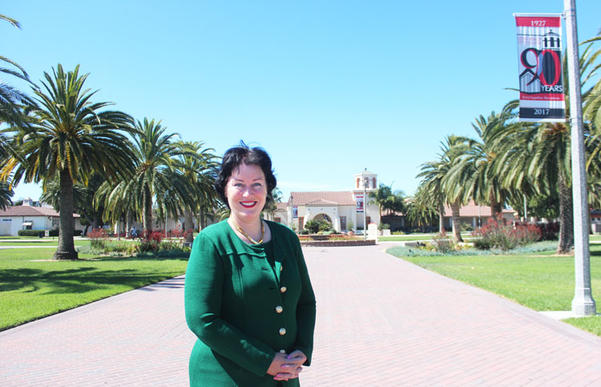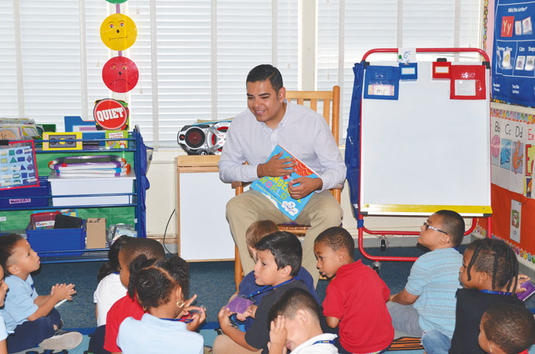The Long Beach College Promise is known throughout the country as a model for local education. According to its architects, it has influenced scores of similar pacts among school districts and colleges throughout the country, and played a part in President Obama’s America’s College Promise as well as the development of a California College Promise.

Mayor Robert Garcia recently visited Grant Elementary School in North Long Beach to read to school children. Garcia is an advocate for universal preschool, or preschool for all. Garcia is pictured with, from left: Gloria Guillen, teacher; Kimberly Kelly, coordinating teacher; and Felicia Fortenberry, teacher. (Photograph by the Business Journal’s Pat Flynn)
Since 2008, the promise program has afforded students enrolled in the Long Beach Unified School District (LBUSD) the opportunity to attend Long Beach City College (LBCC) with one semester – and now, one academic year – free, and guaranteed a seat at California State University, Long Beach (CSULB) for those who met certain requirements. In 2014, Mayor Robert Garcia made the City of Long Beach a signatory to the promise program, expanding internships for local students and adding more opportunities for preschool education throughout the city.
The promise is a pact between students, the city and the city’s three public education institutions. Students pledge to meet certain academic requirements, and, once achieved, their educational future is guaranteed at the local college and university.
The promise grew out of a concept called seamless education that was introduced in the 1990s to help uplift the city, recalled Christopher Steinhauser, superintendent of LBUSD. Steinhauser is now in his 17th year in this position.
“The city was undergoing a massive loss of jobs, even more so than in 2008, because we lost the Naval shipyard, [and] McDonnell Douglas was basically being phased out and bought by Boeing at the time,” Steinhauser said. “Within a period of a couple years, the community lost 50,000 jobs. And then of course at the same time you had civil unrest. You had the riots of the early ’90s.”
Then-Mayor Beverly O’Neill and local businessman George Murchison brought the leaders of LBUSD, the city college and the university together to create “a world class educational system” that would attract businesses and jobs, and encourage residents to stay in the city, Steinhauser recalled. “We were in a room for three days locked up basically,” he said. “And out of that came this whole idea of seamless education.”
The concept of seamless education was for the institutions to work together toward certain goals. “We targeted how we could ensure that all kids would be reading by the end of third grade. We targeted how we could prepare more kids for college, and what would that look like. We started bringing people together,” Steinhauser said.
This informal pact to work together eventually blossomed into the Long Beach College Promise. “That really formalized what the institutions were going to do for students,” Steinhauser said. At the time, there were a few similar programs around the country, but Long Beach’s was the first to have all three levels of education involved, he explained. “I would still argue that Long Beach’s promise is probably the most detailed in depth,” he said.
The original signatories to the promise for their respective institutions were Steinhauser, former Long Beach City College Superintendent-President Eloy Ortiz Oakley, and then-CSULB President F. King Alexander. Steinhauser is the last man standing, so to speak, of the original signatories. But, even with changes in leadership at the college and university, Steinhauser said the promise program has only grown for the better, with each new leader just as committed to the program as the last.

Reagan Romali is the superintendent-president of the Long Community College District, which offers two free semesters of tuition through the Long Beach College Promise to students from the Long Beach Unified School District who meet certain requirements. (Photograph by the Business Journal’s Brandon Richardson)
Current LBCC Superintendent-President Reagan Romali began her position with LBCC about a year and a half ago, after having worked at Harry S. Truman College in Chicago. “I see it as the great social equalizer,” Romali said of the Long Beach College Promise. “Long Beach struggles with poverty. . . . And the one thing that pulls people out of given circumstances is education and then placement into a job. So the promise levels that playing field and allows them to get the education that they deserve, and then turn around and flip that into a job,” she explained. “The promise translates into a more financially sound life. . . . I think it’s really at the core of economic development and social mobility in Long Beach.”
In the 2015-16 academic year, Long Beach City College expanded opportunit
ies for promise students by extending a guaranteed free semester of tuition to two semesters. The college largely relies upon private donations to its foundation to fund these Long Beach College Promise scholarships. Some students also receive funds through the California College Promise Grant, formerly known as Board of Governors (BOG) fee waivers.
“Every year the foundation gives out about a half-million dollars in scholarships, and that has been going on since 2012,” Romali said. “It comes through the foundation and it comes through local donors,” she said, noting that a local couple recently gifted the foundation a house that was sold for $1 million to fund these scholarships. “It’s really magical to see how generous people are with opening their wallets to help someone else get ahead,” she noted.
Having the mayor add the city as a promise partner in 2014 made the program even more unique among peer programs, according to Steinhauser, who called Garcia “the education mayor.”
“I always say I am an educator who also happens to be the mayor. And I will be an educator after,” Garcia told the Business Journal. “That’s really what I have built my life around. . . . And I think it actually guides how I lead.”
One of the first steps Garcia took as mayor was to give a speech announcing his intention to make the city a party to the Long Beach College Promise. “Our focus has been on early childhood ed[ucation]. We have been working on expanding preschool seats, which we have. We have worked on building the preschool Educare center in North Long Beach, which will be the largest preschool in the city,” Garcia said, referring to a new preschool slated to open soon.
Garcia also started the Mayor’s Fund For Education, a nonprofit dedicated to funding early education efforts. “It’s really important for people to understand that preschool is the absolute best investment in the education spectrum, and that’s why it has been important for me,” he said.
Since joining the promise, the City of Long Beach has doubled the number of internships offered to local high school and college students. “We always try to focus on paid internships, unless there is some specialized college credit internship,” Garcia said.
The promise has afforded opportunities to grow connections and inter-institution programming among the school district, college and university. For example, an emphasis has been placed on offering LBUSD students more opportunities to take dual enrollment courses at LBCC so that they can simultaneously earn high school and city college course credits, according to Steinhauser. “I probably have a couple thousand kids in dual enrollment right now. That will continue to grow,” he said.
The school district also works closely with CSULB’s College of Education because many of the teachers who graduate from that program end up working for LBUSD, the largest employer in the city. “I meet on a monthly basis with the dean of the school of education. So we are always on the cutting edge of new projects,” Steinhauser said.
The Long Beach College Promise won the Governor’s Innovation Award three years ago, an honor that included a grant to create an engagement campaign aimed at ensuring local families are aware of the promise program. Now in its third year, the effort will wrap up soon unless more funds are identified, according to Hilda Martinez, executive director of public engagement for the effort. Martinez is based at CSULB.
“The first goal really was to build awareness of the college promise so that everybody knew about it and was taking advantage of it,” Martinez said. “And the second goal was to reach out to socio-economically disadvantaged communities.” Awareness of the promise was studied by zip code, and neighborhoods were then targeted for the campaign, she explained. “What we found, no surprise, is that the bulk of folks who didn’t know about the promise lived in North and West Long Beach,” she said. Martinez said she would like to partner with LBUSD to add questions to the its annual survey that goes out to local families in order to determine if the campaign is making an impact.

Mayor Robert Garcia recently visited Grant Elementary School in North Long Beach to read to school children. Garcia is an advocate for universal preschool, or preschool for all. Garcia is pictured with, from left: Gloria Guillen, teacher; Kimberly Kelly, coordinating teacher; and Felicia Fortenberry, teacher. (Photograph by the Business Journal’s Pat Flynn)
The next step for the college promise is debuting soon, and will focus on a new workforce component designed to place local graduates in Long Beach jobs. Beyond that, the details are hush-hush until a formal announcement is issued in the coming weeks.
“It’s going to be another nationwide model that people are going to use as an exemplar and benchmark against how to take college and feed it seamlessly into a job,” Romali said of what she calls Promise 2.0. “There is a meaningful connection where not only are we going to give you your diploma, we’re going to place you in a job in your local community if that’s where you want to live. We are going to have a model that’s going to do that,” she said.
“We want students who graduate out of Cal State Long Beach to get a job locally or to be able to stay here,” Garcia said. “Right now we are losing and bleeding thousands of students who leave Long Beach and can’t find a job here. . . . Ideally, if someone wants to stay in Long Beach they’ll be able to.”
Both Garcia and Steinhauser pointed out that the issue of housing affordability needs to be addressed in order for professionals to be able to stay in Long Beach. “We cannot sustain ourselves with housing that is unaffordable to working professionals,” Garcia said. “We have got to keep building more at density, particularly in the non-suburban neighborhoods.”
Steinhauser agreed. “The average house now is over $500,000, probably closer to $600,000. And that’s a fixer upper,” he said. “As an educator as well as a parent, I want my young people to be able to stay here and work here and live here and not be priced out of the community. Because that’s going to be the strength of the community: the future generation.”
Garcia said that the Long Beach College promise is the “best citywide program we have as a community.” He added, “We are a national model when it comes to the education system.”
